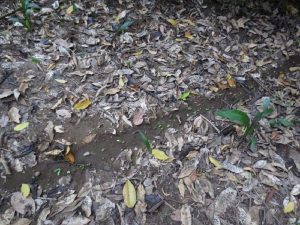A couple of weeks ago, if you asked me what my absolute least favorite bug was, I would have rushed to say “ANTS! ANTS! MOBS OF ANTS!” before you finished asking your question. I used to think of ants (especially in groups of 4 or more) as annoying little pests whose sole purpose was to attack any and every crumb I might have in my kitchen, or worse, my dorm room. Our first hike in Costa Rica changed all of that.
On our second day in Costa Rica, we decided to explore a little hiking trail next to our lodge through the Teak Tree forest in Hacienda Baru. As we were walking, Ryan (one of our tour guides) came to a sudden halt and directed our attention to the ground. We looked down and saw a trail of tiny bits of dancing green leaves cutting across the trail only to realize that there were little ants beneath the leaves carrying them to their nearby underground colony. As Ryan explained to us more about these small critters, the more I became absolutely fascinated by these creatures that I normally would have wanted nothing to do with.
Leafcutter ants, as I learned they were called, are known to be the most complex animal societies next to humans. With an entire caste system intact within each colony, these ants are able to function like a well-oiled machine so to say, as they are technically a farming
society. As each caste does its individual job, the ultimate goal is to feed the growing colony by harvesting fresh leaves that are used as compost for fungus food to grow on. Besides the queen ant, whose responsibility is being the sole reproducer for the colony, there are three different castes—the workers, the soldiers, and the minima. The workers, also known as mediae, travel long distances in the jungle to find the perfect leaves for their farm. It seems peculiar and even dangerous to travel such a long way but they do so because they are smart enough to know that they need the foliage around their colony to protect it from the rain. Once the medias find suitable leaves, they leave a chemical scent trail for other workers to follow. As they cut and carry the leaves back to their colony, other smaller ants, the minimas, ride on top and clean the leaves before they are allowed underground for the farm. These minimas also do a majority of their work underground, tending to the growing fungus inside of the colony. The soldiers are the largest subcaste and weigh about 7 times more than medias and 30 times more than minimas. Their primary responsibility is to protect the colony from intruders and do so by using their massive jaws and stings. They also clear the trail by moving things the medias and minimas cannot carry. When all three castes work together, they can maintain a colony the size of a small car inhabited by about 5 million ants. The level of organization and sheer size of these leafcutter ant colonies is truly fascinating.
While we were in Costa Rica, we also ran into another kind of ant species—army ants. While we were working on the greenhouse behind the elementary school in Mastatal, we heard a sudden flock of birds flying out of the trees and a rush of bugs zooming past us, as if they were running for their lives. Within a couple of seconds, we saw a sea wave of ants storming up over a small hill out of the jungle. They swarmed on such a massive scale, it was as if the ground was painted black. It was clear that this colony of army ants was on the hunt. Although they are incredibly smaller than other bugs, they worked as a team to trap and kill bugs as big as cockroaches and spiders. After doing more research, I found out that they kill about 100,000 animals a day—mostly insects but they are also capable of killing lizards, snakes, chickens, and other small mammals. One of the most fascinating things about these critters is that the majority of them (all besides the queen and males) are blind and rely solely on chemical trails to find their way around and execute massive raids. As a nomadic species, these ants are almost always on the move except for when they create nests out of their own bodies to shelter growing larvae. Army ants, although seen as extreme pests, actually serve as natural pesticides as they clear out any unwanted bugs in farms and even human homes.
Getting the chance to watch an army ant raid in person was an incredible as well as humbling experience. While back in the States we are used to forcing nature to work around us, this time we were the ones being forced to stop our own work in order for nature to proceed in its intended course. Knowing what I know now about leafcutter ants and army ants, it’s hard to believe that I once loathed such mesmerizing creatures.


